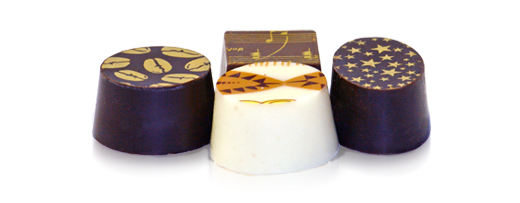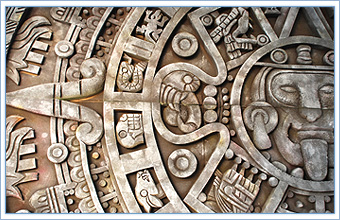 Chocolate is often thought of as a rich, creamy food—a favorite ingredient
in many dishes and a luscious indulgence in its own right. But
for most of the history of chocolate, (90%) people enjoyed it as a drink. We
tend to think of chocolate as a sweet candy created during modern times.
But actually, chocolate dates back to the ancient peoples of Mesoamerica
who drank chocolate as a bitter beverage. Chocolate played important
role in the religious and social lives of the people of Mesoamerica.
Chocolate is often thought of as a rich, creamy food—a favorite ingredient
in many dishes and a luscious indulgence in its own right. But
for most of the history of chocolate, (90%) people enjoyed it as a drink. We
tend to think of chocolate as a sweet candy created during modern times.
But actually, chocolate dates back to the ancient peoples of Mesoamerica
who drank chocolate as a bitter beverage. Chocolate played important
role in the religious and social lives of the people of Mesoamerica.
Among the many treasures found by the Spanish when they conquered the
Aztecs was the native chocolate drink. The native chocolate drink
was too bitter for their tastes and the Spanish added sugar, cinnamon,
cardamom and other spices to sweeten and flavor it. For almost a
century the Spanish managed to keep this delicious chocolate drink a
secret. Over time this chocolate beverage
in varied versions
began to take hold throughout the continent of Europe.
The chocolate
drink became exclusive to the continent’s elite.
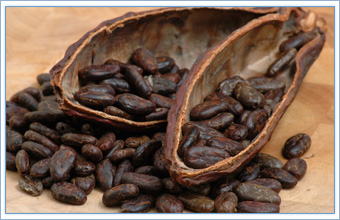 Chocolate
is more than just a food. Its rarity and richness have secured it a
special status in history.
For hundreds of years and in many different cultures, the act of eating
chocolate has taken on symbolic significance. Chocolate has been linked
to power, religion, medicinal remedies and romance—especially when chocolate
was considered an expensive and rare luxury.
Chocolate
is more than just a food. Its rarity and richness have secured it a
special status in history.
For hundreds of years and in many different cultures, the act of eating
chocolate has taken on symbolic significance. Chocolate has been linked
to power, religion, medicinal remedies and romance—especially when chocolate
was considered an expensive and rare luxury.
New machines during the mid-1800s made it possible to inexpensively mass-produce
solid chocolate candy. Chocolate was no longer a rich person’s
treat, chocolate became affordable and available to a much wider audience. As
a result today, chefs in many countries have incorporated chocolate into
specialty dishes, desserts, and drinks so that this sweet can now be
found in some form on most menus around the world.
For centuries, chocolate has been shrouded in mystery and legend. Many
cultures believed that chocolate was a gift from the heavens, or that
it had special healing properties. Maya and Aztec peoples drank
chocolate not only for pleasure, but also for its perceived healing and
nourishing powers. They used it to treat a host of illnesses, such as
seizures, fevers, dysentery, diarrhea, and skin infections.
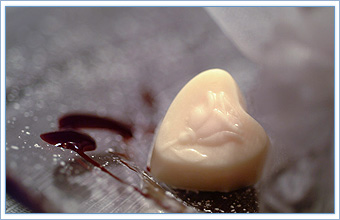
Like most new foods, chocolate was received with mixed reactions by
Europeans. Encountering chocolate for the first time in the 1600s,
some believed it could induce sleep, aid digestion, purify the blood,
ease childbirth pains, and enhance libidos—though others believed it
could cause drunkenness or illness.
Today, many cultures still consider chocolate a potent weapon in
the fight against disease and illness. Modern scientists have only
recently begun to understand what, if any, medicinal powers chocolate
contains. Modern
science says that chocolate may not be all bad for you. For a
long time, the medical profession assumed that traditional folk remedies
using chocolate were pure wives’ tales. Chocolate developed
a bad reputation for causing everything from acne to tooth decay.
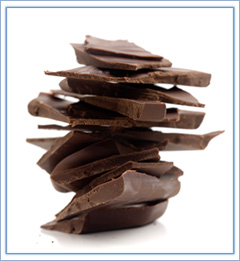 But current research reveals the fact and fiction behind many of these
beliefs. Although scientists are still trying to understand the more
than 300 chemicals in chocolate, there may be some beneficial side
effects to eating chocolate.
But current research reveals the fact and fiction behind many of these
beliefs. Although scientists are still trying to understand the more
than 300 chemicals in chocolate, there may be some beneficial side
effects to eating chocolate.
In Asia, chocolate’s appeal is not as widespread because of national taste preferences. And in Africa, cacao remains an important national export, too valuable for general consumption. (However, chocolate’s popularity is growing gradually in both of these regions of the world.)
Chocolate has won fame worldwide as both a savory flavoring and a
sweet seasoning. Over the centuries, many cultures have incorporated
chocolate into their traditional recipes.
In the Americas and Europe, chocolate reigns as a popular ingredient
in main dishes, side courses, desserts, and drinks.



